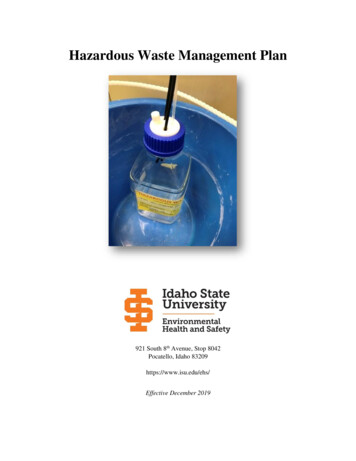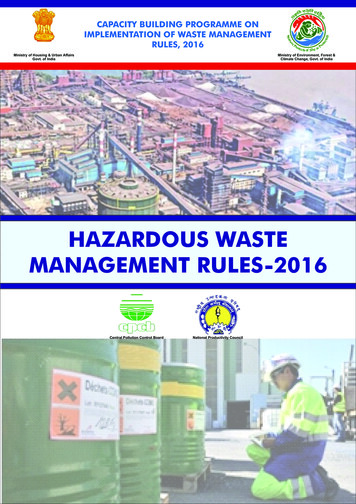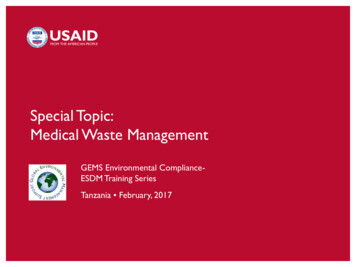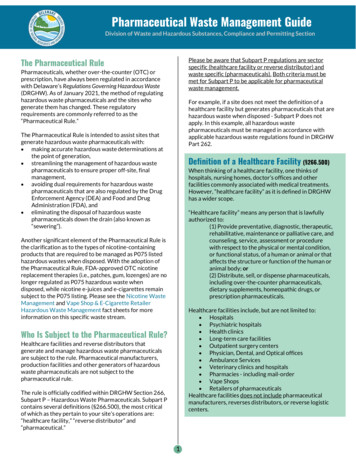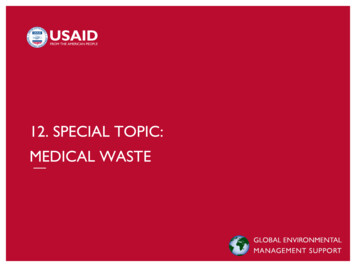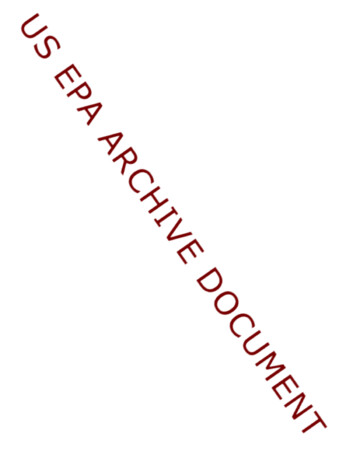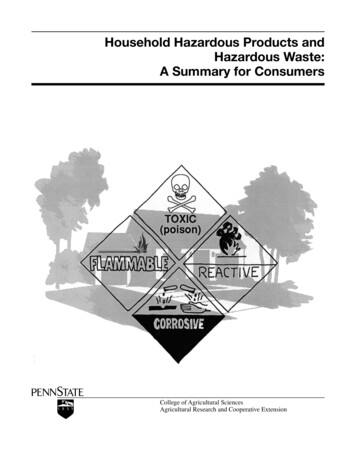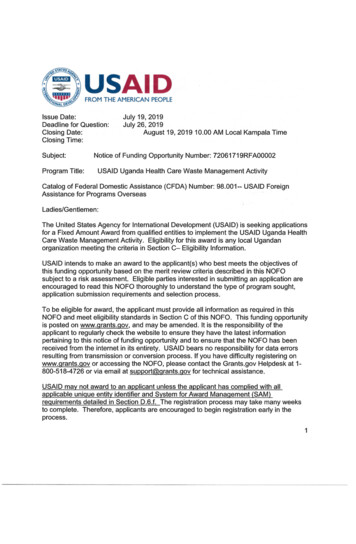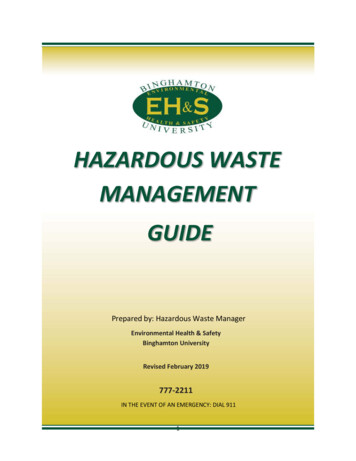
Transcription
HAZARDOUS WASTEMANAGEMENTGUIDEPrepared by: Hazardous Waste ManagerEnvironmental Health & SafetyBinghamton UniversityRevised February 2019777-2211IN THE EVENT OF AN EMERGENCY: DIAL 9111
PURPOSE OF THIS MANUALThis manual has been designed to assist all Binghamton University faculty, staff, and graduatestudents in the safe and economical management of hazardous wastes generated on campus.The hazardous waste manager coordinates the hazardous waste management program includingthe identification of hazardous wastes, compliance with state and federal regulatoryrequirements, hazardous waste storage and disposal, spill response, and hazardous wasteminimization.The role of the hazardous waste manager is to act in the capacity of a consultant for theBinghamton University campus and to provide customer service oriented programs that helpachieve compliance with various state and federal hazardous waste regulations. The input andcooperation of chemical users is an important part in the overall success of the hazardous wastemanagement program.This manual discusses the vital role YOU play in this management effort.This revised guide includes a number of additional sections to better assist the campuscommunity in managing hazardous waste. Please read the guide carefully and call the hazardouswaste manager at 777-2211 if you have any questions. Your comments and suggestions arealways appreciated.2
Contents1.0INTRODUCTION . 62.0YOUR RESPONSIBILITIES. 73.0HAZARDOUS WASTE MINIMIZATION . 73.1Plan Your Experiment. 73.2Maintain a Current Inventory . 83.3Use Recycled Chemicals . 83.4Purchasing Chemicals. 83.5Nonhazardous Substitutes . 93.6Appropriate Storage Practices . 93.6.1General Storage Guidelines . 93.7Chemical Storage Classes . 113.8Cylinder and Lecture Bottles . 113.9Microscale Activities . 124.0DISPOSAL OF NONHAZARDOUS WASTE. 135.0THE HAZARDOUS WASTE MANAGEMENT PROGRAM . 145. 16.0Hazardous Waste Regulations . 14MANAGING HAZARDOUS WASTE . 156.1Hazardous Waste Determination (What is Hazardous Waste) . 156.2Listed Hazardous Wastes (F, U, and P lists) . 166.2.1F-Listed Waste . 166.2.2U and P Listed Waste . 176.2.3Polychlorinated Biphenyls (PCBs) . 176.3Characteristic Waste . 186.3.1lgnitability. 186.3.2Corrosivity . 186.3.3Reactivity . 196.3.4Toxicity . 216.3.5The Mixture Rule . 227.0SATELLITE ACCUMULATION AREAS. 238.0MANAGEMENT PROCEDURES FOR SPECIFIC WASTE TYPES . 258.1Concentrated Solutions of Acids and Bases . 258.1.1Neutralization Procedures . 253
8.1.2Chromic acid. 258.1.3Hydrofluoric acid . 258.1.4Perchloric acid . 268.2Organic Solvents . 268.3Aqueous Solutions of Toxic Chemicals. 278.4Oil . 288.5Asbestos . 288.6Silica Gel . 288.7Chemically Contaminated Items . 298.8Mercury . 298.9Fluorescent Tubes . 308.10Batteries . 308.11Computer Equipment. 308.12Aerosol Cans and Cylinders . 318.13Paint, Paint Thinner, Adhesives, and Printshop Chemicals. 318.14Photographic Chemicals. 318.15Reactive and Potentially Explosive Chemicals . 318.16Peroxide Forming Chemicals . 328.17Unknowns . 348.18Household Hazardous Waste . 349.0HAZARDOUS WASTE DISPOSAL PROCEDURES . 359.1The Hazardous Chemical Waste Tag . 369.2Completing The Hazardous Chemical Waste Tag . 3710.0WHAT HAPPENS TO THE HAZARDOUS WASTE GENERATED ON CAMPUS . 3810.1Bulk Drums . 3810.2Lab Pack Drums . 3810.3Recycling/Reclamation. 3910.4Drain/Trash Disposal . 3910.5Ultimate Disposal . 3911.011.112.012.1SAFETY DATA SHEETS . 40SDSs On The WWW . 41CHEMICAL SPILLS . 42Minor Spills . 424
12.1.112.2Major Spills. 4412.2.112.3Minor Spill Cleanup Procedures . 42Major Spill Cleanup Procedures . 44Fire Alarms . 45APPENDIX A: Binghamton University Management Procedure - Environmental Health andSafety Policy . 46APPENDIX B:F-List . 47APPENDIX C:U and P List . 48APPENDIX D:TCLP CONTAMINANT LIST . 91APPENDIX E:PEROXIDE FORMING COMPOUNDS . 92APPENDIX F:BINGHAMTON-JOHNSON CITY JOINT SEWAGE TREATMENT PLANT REGULATIONS . 93APPENDIX G:SPILL BUCKET CONTENTS . 96APPENDIX H:SCIENCE STORES . 97APPENDIX I:REFERENCE MATERIALS. 985
1.0 INTRODUCTIONIt is a policy of Binghamton University “to maintain an environment tor its faculty, staff,students, and visitors that will not adversely affect their health and safety nor subject them toavoidable risk of injury”. The Environmental Health and Safety Office (EH&S) was established in1974 to provide guidance and services needed by campus personnel to attain the goals andobjectives of the campus environmental health and safety policy.Environmental Health and Safety Mission Statement“With enthusiasm for excellence, the Department of Environmental Health and Safetypromotes and supports a safety conscious campus community through professionalconsultation, education, training, and services”.The following are programs and initiatives developed by your EH&S professional and technicalstaff: Asbestos AwarenessBloodborne PathogensChemical Spill ResponseDisaster PlanningFire and Safety Code ComplianceHazard CommunicationHazardous Waste ManagementHazardous Work PermitsIncident and Hazard ReportsIndustrial HygieneLaboratory SafetyRegulated/Infectious Medical WasteRespiratory ProtectionSafety ConsultationRight to KnowContingency PlanIf you would like more information or want to receive a copy of our brochure detailing theseprograms, contact the Environmental Health and Safety office at 777-2211.6
2.0 YOUR RESPONSIBILITIESAs a chemical user, YOU have a legal and moral responsibility to ensure the proper disposal ofany hazardous waste you generate. There are various state and federal regulations that governthe disposal of chemical wastes. There are also criminal and civil penalties that can result fromimproper disposal of these wastes. In addition to potential citations, fines, and imprisonment;improper waste disposal can also result in national media attention and damage to theUniversity’s reputation.YOU CAN BE PERSONALLY HELD LIABLE FOR “WILLFULLY AND KNOWINGLY” VIOLATING THESEREGULATIONS.You also have a moral responsibility to properly dispose of chemicals that can pose a present orpotential hazard to human health or the environment. This includes accident and injuryprevention to students, coworkers, and the campus community.The Binghamton University management procedure for the policy on environmental health andsafety can be found in Appendix A.3.0 HAZARDOUS WASTE MINIMIZATIONDisposal of hazardous waste is regulated by the U.S. Environmental Protection Agency (EPA) andthe New York State Department of Environmental Conservation (DEC) under the ResourceConservation and Recovery Act (RCRA). The Act makes it illegal to mismanage hazardous wastes.The Act’s emphasis is on waste reduction and recycling. You can help reduce the expenditure ofUniversity funds (and ultimately your department’s funds) on waste disposal and materialprocurement by practicing waste minimization.3.1Plan Your ExperimentInclude waste minimization practices when you are planning for an experiment. Consider thechemicals you will be using and whether or not they will become hazardous waste. Only mix theamount of reagents and stock solutions that you need for the experiment and will be able to use.7
Do not make excess solutions for potential later use. Know in advance how you will be handlingany hazardous waste. Read Safety Data Sheets (SDS) BEFORE working with chemicals tounderstand any hazards and special handling precautions. Allow for time at the end of each dayto clean up, and always practice good housekeeping.3.2Maintain a Current InventoryThe first step to effectively minimizing the amount of hazardous waste you generate is tomaintain a current inventory of all chemicals being used and stored in your lab or work area. Youshould check your inventory first before ordering any new chemicals. It may also be possible toborrow small amounts of chemicals from other labs. Please take the time to check with yourcolleagues.3.3Use Recycled ChemicalsThere is an on-going program of recycling usable but unwanted chemicals. All recycled chemicalsare in their original containers and many still have their factory seals. You can also put in a specialrequest for a particular chemical. Once you have submitted a request, EH&S will look for therequested items(s) in the chemicals that are sent through the hazardous waste managementprogram.If you would like to be included on the e-mail distribution list for surplus chemicals or would liketo request a particular chemical(s), contact the hazardous waste manager at 7-2211.3.4Purchasing ChemicalsWhen ordering new chemicals, only order the amount of chemical that you need for theexperiment you are conducting. Do not order a larger size container for an experiment that willonly last a semester or for an experiment that may occur in the future. Although chemicals usuallycost less per unit when purchased in large containers, when the actual usage, storage, anddisposal are factored in, the cost savings diminish significantly and in some cases result in highercosts overall.In addition, chemicals in large containers that are not used frequently can be rendered uselessover time by contamination or degradation. In general you should only order the minimum8
quantity of a chemical that you need for the experiment, or one year’s worth of stock at theabsolute most.3.5Nonhazardous SubstitutesThere are many nonhazardous substitutes for hazardous chemicals used in laboratories.Hazardous chemicals that should be substituted with nonhazardous alternatives in particularinclude those chemicals that are highly toxic, reactive, contain heavy metals, and are known orsuspected carcinogens, mutagens, or teratogens.Examples of nonhazardous chemical substitutes can be found in reference materials such asPrudent Practices in the Laboratory (see Appendix I). If you are using a specific hazardouschemical on a routine basis, EH&S can research possible alternatives for you.3.6Appropriate Storage PracticesStoring chemicals properly promotes safer and healthier working conditions and extends theusefulness of chemicals. Improperly stored chemicals can result in: degraded containers that allow chemicals to become contaminated degraded containers that can release hazardous vapors that are detrimental tothe health of lab workers degraded containers that can release vapors that can affect the integrity ofnearby containers degraded labels that can result in the generation of unknowns chemicals becoming unstable and/or potentially explosive3.6.1 General Storage Guidelines1)Chemical containers should be dated when they arrive and should be checked regularlyand disposed of if the chemical is past its expiration date. NOTE: Peroxide forming chemicalsare required to be dated (see Section 8.16).9
2)Large chemical bottles should be stored towards the back of a storage cabinet andsmaller bottles should be stored up front where they are visible. Labels should be turned sothey can be easily read.3)For multiples of the same chemical, older containers should be stored in front of newerchemicals, and containers with the least amount of chemical should be stored in front of fullcontainers. This allows older chemicals to get used up first and helps to minimize the number ofchemical containers in the storage area.4)All chemical containers MUST be labeled. Labels must include the name of the chemicalconstituent(s) and any hazards present. You should check chemical containers regularly and besure to replace any labels that are deteriorating BEFORE the chemical becomes an unknown.5)Flammable liquids in excess of the quantities for the specific classes listed below mustbe stored in approved flammable liquid storage cabinets.a)Class IA(flashpoint 73 F, boiling point 100 F)1 pintb)Class IB(flashpoint 73 F, boiling point 100 F)1 quartc)Class IC(flashpoint 73 F, boiling point 100 F)1 gallond)Class II(140 F flashpoint 100 F)1 gallon6)Do not store corrosive chemicals in metal storage cabinets, this can result in seriousdegradation of the storage cabinet and the containers inside. Corrosive chemicals should bestored in corrosion resistant cabinets.7)Do not store flammable liquids in a non-explosion-proof refrigerator. This can result inthe flammable vapors being ignited by the electrical components of the refrigerator. Only storeflammable liquids in explosion-proof (or flammable storage) refrigerators. Explosion-proofrefrigerators have protected electrical components and are designed to store flammableliquids.10
8)Highly toxic chemicals such as inorganic cyanides should be stored in locked storagecabinets.3.7Chemical Storage ClassesChemicals should be stored according to compatibility groups, they should not be storedalphabetically (or otherwise) until they have first been segregated by hazard class. In general,chemicals should first be separated into their organic and inorganic families and then segregatedaccording to hazard class groups. The basic hazard class groups, which are based on theDepartment of Transportation (DOT) hazard classes, include:Flammable liquids (Class 3)Spontaneously combustible (Class 4.2)Oxidizers (Class 5.1)Poisons (Class 6 .1)BasesInorganic acidsFlammable solids (Class 4.1)Dangerous when wet (Class 4.3)Organic peroxides (Class 5.2)CyanidesOrganic acidsOtherBe sure to check Safety Data Sheets (SDS) for any special storage requirements. There are anumber of storage patterns and systems that are recommended by various manufacturers.EH&S has a customized label maker and hazard class stickers for labeling your chemical storageareas and can provide assistance in segregating your chemicals for you. If you would like to takeadvantage of these services, contact the hazardous waste manager at 7-2211.3.8Cylinder and Lecture BottlesDisposal of cylinders and lecture bottles is expensive, especially if the contents are unknown.Make sure that all cylinders and lecture bottles are labeled and includedin your chemicalinventory. Before you place an order for a cylinder or lecture bottle, determine if themanufacturer will take back the cylinder or lecture bottle when it becomes empty. If at allpossible, only order from manufacturers who will accept cylinders and lecture bottles for return.11
3.9Microscale ActivitiesIf possible, consider switching to microscale experiments. Benefits include: reduced costs in chemical purchases and hazardous waste disposal shorter analysis times significantly less glassware breakage compatibility with macro-scale equipment less hazardous chemical exposure to employees and students minimized potential for fires and explosionsless space required for chemical and hazardous waste storage12
4.0 DISPOSAL OF NONHAZARDOUS WASTEBinghamton University does not advise the disposal of non-hazardous chemicals by trash orsanitary sewer. Chemicals not regulated today, could be in the future, and the generator ofchemical waste can still be held liable in the future if a particular chemical became regulated.This is referred to as “retroactive liability” under the Comprehensive Environmental Response,Compensation and Liability Act (CERCLA), ie “Superfund”. A good example of this is the disposalof PCBs before they were regulated. There are numerous sites across the country that are nowSuperfund sites because of past disposal practices of PCBs- even though the disposal practiceswere acceptable at the time. Many institutions, including universities, that followed theseaccepted disposal practices are now being asked to fund the cleanup of these Superfund sites.It is also important to keep in mind the stigma attached with the disposal of chemicals in thenormal trash. This is especially true when chemicals are discovered in the trash by other membersof the campus community who may not have the technical knowledge needed to identify andevaluate those chemicals. This type of situation can quickly escalate into unwarranted attentionfrom the media and regulatory agencies. Please be aware of the concerns people have withregard to their health and safety when discovering strange and unknown chemicals in the trash.In an effort to minimize any potential incidents, Environmental Health and Safety recommendsdisposing of all chemical wastes through the hazardous waste management program.Please keep in mind that improper disposal of hazardous wastes can result in fires, chemicalreactions, release of toxic or noxious gases and vapors, corrosion of the plumbing system, andcan result in other environmental problems at the sewage treatment plant.NOTE: Dilution is not allowed as a treatment method for hazardous waste.13
5.0 THE HAZARDOUS WASTE MANAGEMENT PROGRAMThere is a large variety of chemical waste generated at Binghamton University. Nearly all facetsof the campus community generate some form of hazardous waste. Examples include: flammable, corrosive, reactive, and toxic laboratory waste waste solvents from vehicle maintenance, printing, and painting operations corrosive wastes from cleaning operations waste fixer and photographic chemicals from darkrooms paints, thinners, corrosives, and metal containing wastes from art studios other miscellaneous wastes from across campusThe management of hazardous waste generated on campus includes: information on safe chemical handling, storage, use, and disposal hazardous waste collection and disposal laboratory and work area cleanouts spill responseThe first step in the hazardous waste management program is for you to recognize yourresponsibilities as a chemical user according to the hazardous waste regulations, understand thehazardous waste management system, and implement the procedures described in this guide.You are also responsible for making every technical andeconomically feasible effort to minimizethe volume of surplus chemicals and the amount of hazardous waste that you generate.5. 1Hazardous Waste RegulationsHazardous waste is regulated by the U.S. Environmental Protection Agency (EPA) and the NewYork State Department of Environmental Conservation (DEC) under the Resource Conservationand Recovery Act (RCRA). Binghamton University is regulated as a Large Quantity Generator(LOG) of hazardous wastes. This guide is intended to provide an overview of managing hazardous14
wastes on a university campus. The complete regulations and additional environmentalcompliance assistance information for colleges and universities can be found at the DEC and EPAwww s://www.epa.gov/hw6.0 MANAGING HAZARDOUS WASTEAs a generator of hazardous waste, there are specific requirements that must be followed inorder to properly handle, store, and dispose of hazardous wastes. These requirements include:1)Make a determination as to whether the chemical wastes you are generating areconsidered hazardous (see Section 6. 1).2)Follow Satellite Accumulation Area requirements (see Section 7.0).3)Follow proper hazardous waste storage and disposal procedures (see Sections 8 and 9).6.1Hazardous Waste Determination (What is Hazardous Waste)The U.S. EPA and New York DEC consider a waste to be hazardous if it:(a)is a Listed hazardous waste (see Section 6.2)(b)exhibits certain hazardous characteristics (see Section 6.3)ORIn addition to the two criteria above, Environmental Health and Safety also considers chemicalwaste to be hazardous if it:(c)has an oral Lethal Dose (LD50) for a rat of less than 500 mg/kg(d)if the original container identifies the chemical as toxic or poisonousOR15
OR(e)If the chemical is a known or suspected carcinogen, mutagen, or teratogenTo summarize, a chemical waste exhibiting any one of these five criteria is to be considered ashazardous waste and must be managed accordingly through the hazardous waste system.When in doubt, dispose of chemical waste through the hazardous waste managementprogram.6.2Listed Hazardous Wastes (F, U, and P lists)The EPA and DEC have several lists of chemical wastes that are regulated as hazardous wastes.Three of the lists that apply to Binghamton University are the F-list, U-list, and P-list.6.2.1 F-Listed WasteChemical wastes found on the F-list are hazardous wastes from nonspecific sources. Althoughthere are 39 listings (F001- F039), the most common F-listed wastes generated on campus areF001, F002, F003, F004, and F005. The chemicals listed are primarily both halogenated and nonhalogenated organic solvents. See Appendix B for a description of the chemicals on the F-list.Some common examples of F-listed hazardous wastes include:a)A graduate student working in a science laboratory uses Acetone as a final rinse forcleaning glassware, the Acetone waste that results is considered a F003 listedhazardous waste. This Acetone rinse cannot be disposed of down the drain and mustbe managed as a hazardous waste.b)A maintenance worker uses a 10% solution by volume (or greater) of Methylenechloride as a degreasing agent. The waste that results is considered a F001 listedhazardous waste and must be disposed of through the hazardous wastemanagement program.c)A person working in a Fine Arts department uses a trade name paint brush cleanerthat contains 10% or more (by volume) of Toluene. The waste that results isconsidered a F005 listed hazardous waste and must be managed accordingly.16
6.2.2 U and P Listed WasteThe EPA and DEC regulate certain chemical wastes as being Toxic Wastes (U-list) and AcutelyHazardous Wastes (P-list). The U and P codes are assigned to chemicals that are discardedcommercial chemical products, oft-specification species, and container residues. The EPA andDEC also regulate any residue or contaminated soil, water, or other debris resulting from thecleanup of a spill involving a U or P listed chemical as hazardous waste. It is also EH&S policy thatany mixture of chemicals that contain ANY concentration of U or P listed chemicals is consideredto be hazardous waste and must be disposed of
As a chemical user, YOU have a legal and moral responsibility to ensure the proper disposal of any hazardous waste you generate. There are various state and federal regulations that govern the disposal of chemical wastes. There are also criminal and civil penalties that can result from improper disposal of these wastes.
